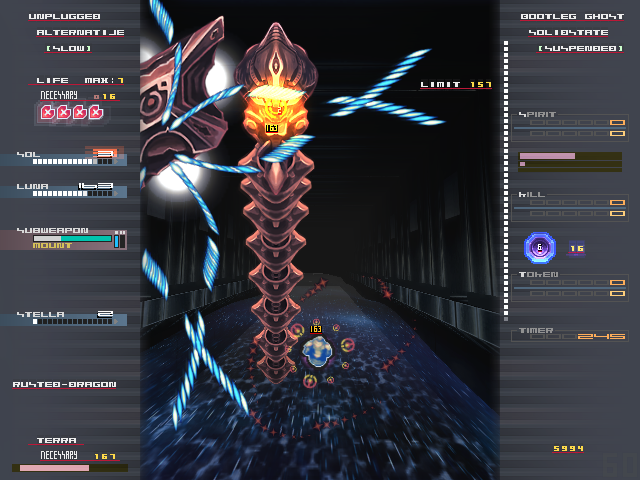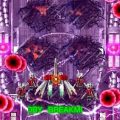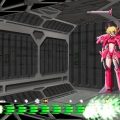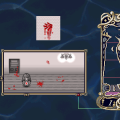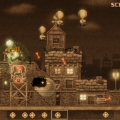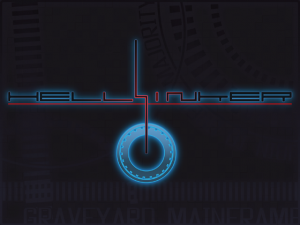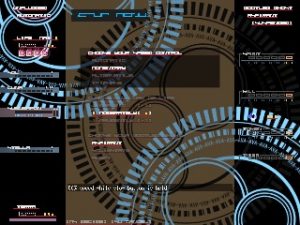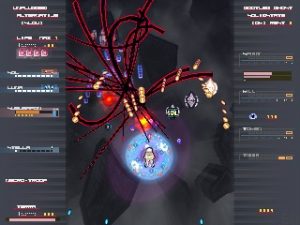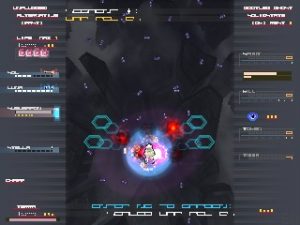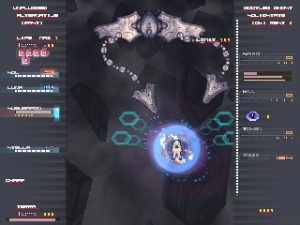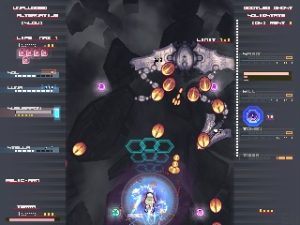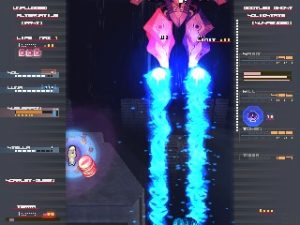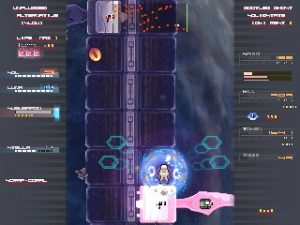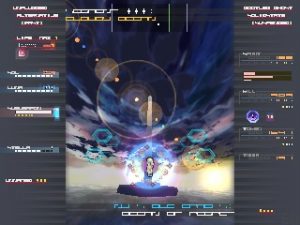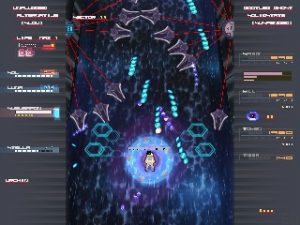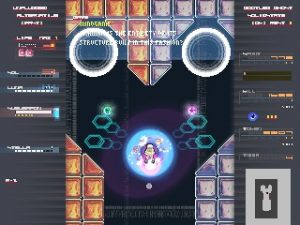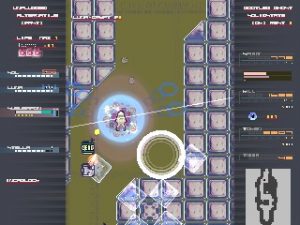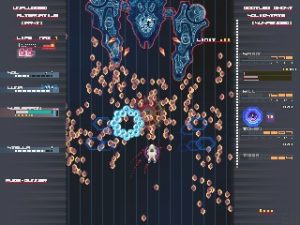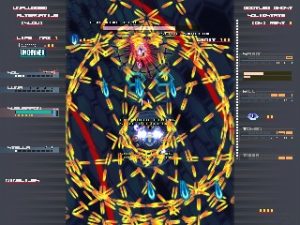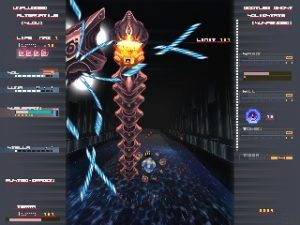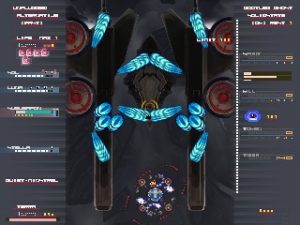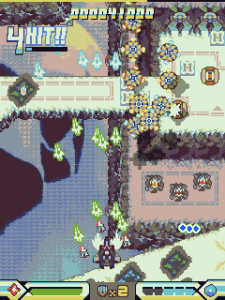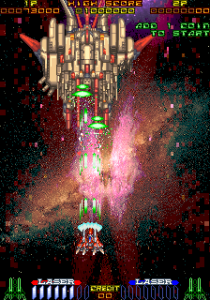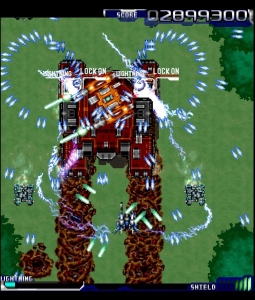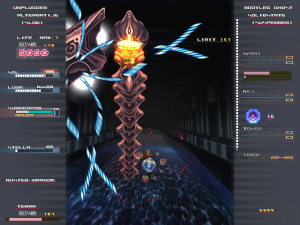
When compared to most other shoot-em-ups, Team Ruminant’s Whimper’s Hellsinker is a riddle wrapped inside a mystery inside an enigma. It’s visually sparse and often bizarre, with tons of hidden imagery and mysterious codes hidden throughout, its soundtrack is a cacophony of synth sounds and distorted voices, and the gameplay itself is difficult to handle at first due to the many, MANY unexplained mechanics and terms involved in it. It’s a lovably weird, obtuse mess of a game that has little-to-no appeal to anyone but the most hardcore of shoot-em-up fans, and that is what makes it stand out as one of the most unique entries in the genre.
To fully understand and appreciate Hellsinker‘s brilliance, not only its gameplay, but also its plot must be analyzed in detail. To quote the included digital manual/guidebook:
“PROLOGUE:
The world itself in chaos since the distant past, habitation difficult.
It was the Final Enemy of which they wrote.
At last, in its quest for survival, humanity formulated a strategy to keep this foe in check.
The people of that age created a Mechanism, a land perfect for life.
And so was rejoiced the age of peace – the Brief Honeymoon.
However, the passage of time proved to be the bane of the Mechanism.
That rhythm of life, reaching from the depths of the earth high into the sky, began to deteriorate, slipped gear by slipped gear, until at last the waves came together.
The waves, overlapping again and again, their amplitude ever swelling–rising to unparalleled heights, and falling just as far.
A failure – a breakdown – appropriate to the grandeur or the Mechanism. It was known as The Collapse.
Had no one seen the disaster coming? Or did they choose not to look?
Or did they see, but fail to act nonetheless?
No conclusion was ever reached.
The strange blend of poetry, verbal symbolism and good ol’ Engrish in the introduction is one of Hellsinker‘s most defining characteristics, and helps maintain the game’s vague and bizarre atmosphere even on its menus and the few short intermission scenes spread throughout the main campaign. In a sense, Hellsinker‘s plot is a tropey tale of a ragtag bunch of super-powered misfits’ (the GRAVEYARD Executor Team and their Misteltoe [sic] companions) quest to fight against ancient evils (the Prayers) and to look for answers (found in the depths of the Cardinal Shaft, which you’ll spend the whole game trying to reach) about their post-apocalyptic world’s dark and troubled past, but the way it’s told, the various subplots contained within and the well-developed characters make it for quite an engrossing and unique storyline with a big fan following on the internet.
Tying into Hellsinker‘s complex lore is its terminology; the way the game and its supplementary materials refer to typical shoot-em-up elements such as bullets, bombs, powerups, extends, auto-bombing and Rank. Taking a cue from Taoism, Hellsinker takes place in a world governed by two opposing-yet-cooperating fundamental forces, Sol and Luna, which in the game itself serve as indicators for your main and sub-weapon’s power level, respectively. Bullets are highly concentrated bundles of minuscule spirits materialized into physical forms by the characters’ psychic powers, Rank (known here as Stella) is the life force of these spirits, bombs are Discharges of raw psychic power, stages are Segments of the Cardinal Shaft and the areas surrounding it, auto-bombs are Bootleg Ghosts, and so on.
Hellsinker is a ridiculously deep game even when not considering its cryptic terminology and plot, since its gameplay mechanics resemble that of Battle Garegga by the way of Ikaruga and Radiant Silvergun, with elements of several other highly-regarded shoot-em-ups thrown into the mix. The Garegga connection comes from the way in how the Rank and medaling – or rather, tokening – systems present in Hellsinker work, while the Treasure flair is noticeable in the game’s level design and weapon mechanics. Destroyed enemies drop Tokens of all shapes and sizes, with each one of them affecting the gameplay in one way or another: Sol tokens increase your main shot’s power, the smaller Luna tokens power up your sub-weapon (except when playing as Minogame, who we’ll talk about later), purple Lunar Gems increase your Token score, with larger Gems which give larger bonuses being earned through successful chaining, and the tiny Luna Relics (which are earned by successfully grazing through certain types of enemy bullets) give a boost to both your Luna and Stella gauges, increasing your sub-weapon’s power and the game’s difficulty in exchange for higher scores. Like in Treasure’s shoot-em-ups, optimal scoring in Hellsinker is achieved by destroying enemies as soon as they arrive on-screen; doing so spawns extra enemy formations which, when destroyed, rewards you for playing skillfully, which in turn increases the game’s Rank/Stella counter.
Hellsinker‘s Rank system thankfully isn’t as harsh and strict on novice players as Battle Garegga‘s, and this is mostly due to the fact that extends in Team Ruminant’s Whimper’s game are even more frequent than they were in Raizing’s arcade masterpiece. Scoring, however, is altogether a completely different beast, being divided into three different categories which are tracked independently from each other. These categories are Kills, Tokens and Spirits, and while the former two are the game’s versions of your typical shoot-em-up score indicator(s), the latter is increased by survival, grazing and bullet cancelling, among other factors.
Hellsinker doesn’t allow players to choose how many lives they begin the game with, but in exchange it gives you the choice of picking how many of them you can stock in a single run via the Way Of Life system. After picking a character, selecting a weapon set and adjusting how the Slow Movement key works in-game, most players will either pick the “Prudently” Way Of Life (which allows up to seven lives to be stocked) or maybe the “Moderately” one (up to six lives) if they’re feeling brave, but for those who are playing for score, the “Drastic” (five lives) option is the one to go for, since the reduced number of maximum stocks it gives you makes getting the extremely valuable Immortality Bonus – which gives a major boost to all three score types – much easier in exchange for the bigger risks it offers.
This system also highlights the main difference between regular ExTENDS (earned by collecting Life Chips dropped by enemies) and the BreakTHROUGHS earned by reaching certain Spirit and/or Kill thresholds, since the former aren’t as abundant in later stages as they are early in the game (due to the number of Life Chips required for an extra life increasing every time you get one) while the opposite holds true for the latter. Every character also has a “Life Regeneration System” triggered by high Stella levels which continually gives you Life Chips when you’re on your last life, making the fact that the game only gives you two credits to go through its eight stages actually kind of pointless outside of the extra modes, characters, stages and boss battles you can unlock by 1CCing it.
Speaking of characters, Hellsinker has four, with each one having their own motives, backstory, and gameplay style. They are:
Characters:
Deadliar / Blackbox / Tsumura Akihiro
One of GRAVEYARD’s oldest currently active Executors, Deadliar (real name Tsumura Akihiro) is a mysterious, seemingly-ageless man of unknown background who is said to be either undead, immortal or possibly even both. Previously codenamed Blackbox due to his reclusive nature, he has earned the codename of Deadliar after getting stuck behind enemy lines on his own during the first invasion of the Cardinal Shaft and returning to the GRAVEYARD HQ in one piece after a six-month absence, despite his rather middling battle and survival skills.
His gameplay is based around careful positioning of his Misteltoe companion Togari-maru, which can be thrown anywhere on the screen to continually damage enemies around the red-haired artificial fairy and/or caught between the two, with the attack’s damage output increasing the closer they are to each other. He is the only character whose main shot can be given enemy-piercing properties by quickly mashing the fire button, and his charge shot, Dead Array, summons a pair of blades which can be used to quickly destroy enemies directly above him. His Discharge, Carnage Raid, generates a small, extremely powerful point-blank blast of yellow energy which can be delayed by holding the Discharge button down, which makes it a powerful offensive tactic in the right hands.
Fossil Maiden
Fossil Maiden (real name unknown) grew up in the slums of the huge, ten-level layered metropolis in which GRAVEYARD operates, and was taken in as a guinea pig by the organization at a very young age due to her large number of crippling chronic illnesses caused by the city’s pollution and debilitated senses. Because of this, she was expected to live an extremely short and painful life as a test subject for Human-Misteltoe interactions, but the unexpected development of a deep symbiotic relationship with the experimental Misteltoe Saraga-maru greatly improved her health condition, miraculously giving her her senses back for the first time in more than a decade. Her renewed appreciation of life and Saraga-maru’s upbeat demeanor motivated her to become an Executor for GRAVEYARD to, in her own words, “make the world a better place for everybody, so that nobody suffers like I did”.
Her playstyle takes after Dodonpachi in that the range and the strength of her main weapon is determined by whether you tap or hold down the fire button; unlike Cave’s seminal franchise, however, holding down the button sacrifices power for a wider shot, while continually tapping it does the opposite. She has a bullet-cancelling homing shot as her secondary weapon, and can shoot in any direction and through enemy barriers with the help of her Misteltoe companion Saraba-Maru, who can summon a Terra Diver-esque area control field and/or controlled like a 360-degree turret with the Speed Change button. She, unlike other characters in the game, has two Discharges: Curtain Riser is a Raiden/Truxton-style bomb which can be aimed by holding the Discharge button down, while Bacillus Cloak (triggered by using a Discharge right after firing a barrage of normal shots) grants her an extended period of invulnerability in exchange for no other effects. All this versatility makes her the preferred character among superplayers and score chasers, even though Deadliar is the closest thing HELLSINKER has to a main protagonist.
Minogame
Minogame (whose name, when spelled in kanji, represents wisdom and long life per Japanese mythology) is an artificial being who was worshipped as a god by a mysterious cult before being confiscated by Deadliar and his team of EXECUTORS – who he later joined out of free will – for research and investigation purposes. Being a man-made, hermaphroditic deity of mysterious origin, he is a natural at controlling the world’s psychic energies and spirits, something which has perked the interest of most of his GRAVEYARD colleagues, who think that he is the key to uncovering the Cardinal Shaft’s darkest secrets.
Minogame’s main gun is weak and only fires directly forward, but the variety of secondary weapons he has access to more than makes up for it. From homing lasers to close-range attacks to cluster bombs to an area-of-effect blast which continually damages enemies caught on it and gives you temporary invulnerability, this guy has everything, creating an unique playstyle based around destroying enemies at point-blank range, grazing tons of bullets and going all-out on crazy sub-weapon combos. However, all this power often makes the Stella counter skyrocket to absurd levels when playing as him, something which is sure to bother many novice-to-intermediate players who are interested in trying out what may be HELLSINKER’s most unique character. His Discharge, Azure Lotus, is positively boring in comparison, being just a screen-clearing bullet shower which works better as a defensive move than an offensive one due to its low damage output.
Kagura
Behind Kagura’s intimidating suit of armor and cold, silent demeanor lies one of the first Misteltoes ever exposed to human interaction, an artificial fairy so small yet so powerful that most EXECUTORs – even experienced ones like Deadliar – shy away from trying to control her and end up getting controlled by her instead. Because of this, she was used mostly as a weapons testing platform by GRAVEYARD’s members (which explains her abundance of weapon sets in-game), but an unfortunate attempt to synchronize and combine powers with Minogame led her to develop a seething hatred for the hermaphrodite and a general distrust of humans. Severely crippled, Kagura stole an Elder Misteltoe’s suit of armor and four Ordinance Packages and escaped from GRAVEYARD’s headquarters to fight against the Prayers alone, eventually joining the EXECUTORs again if they prove themselves to be worthy of her aid. She is unlocked alongside the second main menu theme, the Segment Location mode and the LEAD variations of Segments 1, 2 and 3 by 1CCing Segments 1 through 4.
In gameplay, Kagura has access to four different Ordinance Packages (read: weapon sets), essentially making her function as four characters in one. Each of these sets offers completely different and unique playstyles:
-KOG-07S “GROOM EATER” – Moon Cradle (Multi-Trajectory Shell): Kagura’s “standard” weapon set, which consists of a basic forward-firing gun with slight aiming and explosive capabilities, a free-range area-of-effect blast as its secondary weapon and a temporary barrier as its Discharge.
-KOG-0FS “NO CHASER” – Xanthez (Anti-Bacillus Saber): A set whose combination of a powerful, limited-use lock-on weapon and rotating sword attacks a la Radiant Silvergun makes for an interesting playstyle focused almost strictly on close-quarters combat, something which you don’t usually see on most shoot-em-ups. Both its charge shot and Discharge revolve around a brief burst of blue laser beams which does huge damage but doesn’t last very long and which can be used frequently due to its low Sol cost.
-KOG-06S “PAIN KILLER” – Ecliptic Chariot (External Gunner): This set gives Kagura control over an external gunner/armor unit which can either be used to boost its main gun’s power or strategically positioned to give your shots a wider range and penetrate enemy barriers, essentially making the game play like a danmaku version of R-Type [LINK TO ARTICLE]. Its charge shot allows it to attack diagonally at close range, and its Discharge stays on-screen for quite a while, motivating players who pick this weapon set to play defensively.
-KOG-0CS “PROMISED DAWN” – Infernal Sabbath (Variable Gun): Infernal Sabbath gives you only a standard gun and a puny Discharge to work with, but in exchange, the sub-weapon button allows you to adjust the width and power of your shots anytime you want to, making this the ideal gameplay style for beginners despite its low scoring potential.
Unlike most other shoot-em-ups, where the selectable ships offer only slight variations of the same basic attributes, all characters in Hellsinker are very different from each other, offering a variety of playstyles suitable for all kinds of players, from newbies who play only for survival to score-attack-crazy veterans, with the only thing all characters have in common being the Suppression Field system, which slows down grazed enemy bullets and converts them into Luna Chips if the player stops shooting for a while. Even when not considering this huge variety in character choices, Hellsinker is a surprisingly meaty game for its genre, with tons of content waiting to be unlocked by its players. Besides the secret character Kagura and the usual level/boss practice and sound test modes, many more goodies are unlockable by reaching certain parts of the main campaign in only one credit, from alternate title screens and menu themes a la Mario Kart to alternate versions of the first three stages to a pair of ultra-hard extra stages which, when beaten, nicely wrap up the game’s storyline. And that’s not counting the huge number of crazy scoring tricks and hidden Life Chips each stage hides!
The bosses are another standout aspect of Hellsinker, with almost all of them being massive, screen-filling, multi-form affairs. Some of them, like the Stage 2 LEAD boss Scarlet Queen and the Stage 7 boss Rex Cavalier, even have crazy-hard hidden forms whose appearance is triggered by reaching very specific conditions, and which usually reward you greatly when defeated. Curiously, the game’s true last boss, Lost Property 771/The Unnamed 771, can be encountered by either performing well in the game and defeating the final boss (who will be different depending on how well you perform in the final stage) under certain conditions or as the boss of Extra Stage 2, basically allowing players of all skill levels to reach it – and subsequently the game’s true ending – with enough practice.
From a level design standpoint, Hellsinker is reminiscent of Ikaruga and Radiant Silvergun in that enemy waves and bullet patterns are perfectly synced up to the game’s fantastic soundtrack and that players must deal with each stage’s terrain as they blast through enemies, but unlike in those games, direct contact with anything other than bullets merely push you back a bit, which can still be quite dangerous in some situations. The first three stages also have harder “LEAD” variations unlocked by 1CCing stages 1 through 4 (where your character takes the lead in the assault against the Prayers and the Cardinal Shaft), and all stages go through slight changes when played through the unlockable Short Mission mode.
Out of the game’s thirteen or so stages, the most unique and memorable is, without a doubt, the Shrine of Farewell, which plays like a subversion of your typical shoot-em-up bonus stage: it’s accessed by lowering your Terra level to zero and completing any stage, whereupon the “seal to the spirit world” is broken and the player’s soul is sent to deal with the tortured souls who inhabit it before being allowed to progress normally. The stage itself is a non-stop boss rush against the Shrine’s four guardians (five if you manage to defeat the first four under a certain time limit) with a few mid-bosses interspersed between them, all while your Stella level is constantly rising, with no way to lower it. The catch is that all your scores are reset to zero upon entering the stage, with your final, re-adjusted score being determined by how well you performed on it: how many lives you lost, how many bombs you used, and how many Crystals you collected after everything is over (the Crystals themselves also have varying values depending on your general performance). So while you are granted infinite lives for the duration of this “bonus stage”, it’s possible to actually finish it at a considerable disadvantage if you perform badly on its multiple ordeals, which is something unusual not only for shoot-em-ups, but for videogames in general. Considering how Terra is lost by performing badly in regular stages and how you are forbidden from continuing after going through it, entering the Shrine of Farewell can be considered either a curse or a blessing depending on your knowledge of Hellsinker‘s intricacies and general level of skill in shoot-em-ups, especially if you are willing to sacrifice your single Continue for a higher score.
Taking another cue from Radiant Silvergun, Hellsinker puts its character sprites over 3D polygonal backgrounds that twist and turn as you progress through the stages, giving the game an unparalleled among doujin shoot-em-ups sense of depth and immersion. The initial stages’ backgrounds are admittedly pretty dull, what with their murky color pallete and near-constant rainfall, but things get more interesting once you reach the Cardinal Shaft, which is presented in-game as a series of tunnels, halls and shrines that eventually give way to a massive computer matrix, with the absolutely bonkers final boss battle throwing out every graphical effect the game has under its sleeve at you once you reach the top of the tower where the “FATAL ATTRACTION BE DESCRIBED AS ‘Hellsinker‘” resides. While the game’s sprites are small and lacking in detail when taken in on their own, most large enemies and all bosses are composed of several sprites for each separate body part jointed together (again akin to Treasure’s and Raizing’s games), which gives them the extremely fluid animation that is expected from all good modern shoot-em-ups. Every destroyed bit of a boss’ body drop Tokens and counts towards your Kill score, further motivating those who play for score to take their time when battling against the Prayers. The soundtrack, with its surprisingly effective combination of drum-n-bass, trip-hop, hardcore techno and distorted chorus chanting is a perfect match for the game’s bizarreness, especially when considering how enemy movement and bullet patterns is perfectly synced up to it most of the time.
If there is one complaint to be made about Hellsinker, is that the game presenting itself as a mystery to be deciphered limits its appeal to only the most hardcore of shoot-em-up players who are willing to test their puzzle-solving skills, which is a pretty small audience, for nobody’s surprise. The game also suffers from an inconsistent and uneven difficulty curve, with two notable sudden difficulty spikes being the Shrine of Farewell and the fights against the Rusted Dragon and the Apostles of the Seed in Segments 4 and 6, respectively. The game is also fairly long, with a good playthrough taking about one hour to complete, most of which will be spent in boss battles.
Besides these small issues, however, Hellsinker is one of the best doujin shoot-em-ups out there, and one of the few that deserve to stand alongside the best games of the genre without feeling like a ripoff of any existing game(s). Hellsinker was originally released commercially in Japanese at 2007’s Comiket 72 with the usual extra material like OST and AST discs, but was eventually translated to English by the gensyoko.org team and released for free on the internet. In 2013, this fan-made patch was promoted to being an official translation when the game was released internationally with Team Ruminant’s Whimper’s approval for a brief period of time as part of Groupee’s second Let’s Build A Doujin! bundle, which sadly isn’t available anymore.
